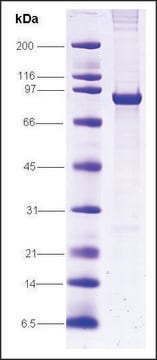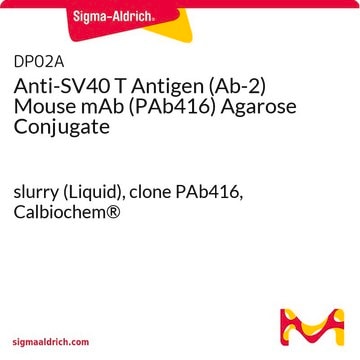DP02
Anti-SV40 T Antigen (Ab-2) Mouse mAb (PAb416)
liquid, clone PAb416, Calbiochem®
Sign Into View Organizational & Contract Pricing
All Photos(1)
About This Item
UNSPSC Code:
12352203
NACRES:
NA.41
Recommended Products
biological source
mouse
Quality Level
antibody form
purified antibody
antibody product type
primary antibodies
clone
PAb416, monoclonal
form
liquid
contains
≤0.1% sodium azide as preservative
species reactivity
SV40-infected cells
manufacturer/tradename
Calbiochem®
storage condition
do not freeze
isotype
IgG2a
shipped in
wet ice
storage temp.
2-8°C
target post-translational modification
unmodified
General description
Purified mouse monoclonal antibody generated by immunizing mice with the specified immunogen and fusing splenocytes with NS-1 mouse myeloma cells (see application references). Recognizes the ~94 kDa SV40 large T antigen.
Recognizes ~94 kDa SV40 large T antigen in SV80 and SV-T2 cells.
SV40 T Ag (Ab-2) is a mouse monoclonal antibody with specificity for antigenic determinants unique to the SV40 large T antigen and non-reactive with SV40 small T antigen. Both antigens are encoded by the early region of the SV40 genome. The large T antigen binds DNA, and complexes with a 53,000 dalton cellular transforming protein, p53, which is required for initiation of viral DNA replication during lytic growth. In addition the large T antigen binds DNA polymerase and the transcription factor AP-2 and forms a specific complex with the p105 product of the retinoblastoma susceptibility gene.
This Anti-SV40 T Antigen (Ab-2) Mouse mAb (PAb416) is validated for use in Affinity Purification, Immunoblotting, IF, IP, Paraffin Sections for the detection of SV40 T Antigen (Ab-2).
Immunogen
Epitope: Within amino acids 83-128
purified SV40 large T-antigen
Application
Affinity Purification (use Cat. No. DP02A)
Immunoblotting (1-5 µg/ml, see application references)
Immunofluorescence (1-5 µg/ml)
Immunoprecipitation (1-5 µg antibody, use Cat. No. DP02A)
Paraffin Sections (see application references)
Immunoblotting (1-5 µg/ml, see application references)
Immunofluorescence (1-5 µg/ml)
Immunoprecipitation (1-5 µg antibody, use Cat. No. DP02A)
Paraffin Sections (see application references)
Packaging
Please refer to vial label for lot-specific concentration.
Warning
Toxicity: Standard Handling (A)
Physical form
In 50 mM sodium phosphate buffer, 0.2% gelatin, pH 7.5.
Analysis Note
Negative Control
3T3 cells
3T3 cells
Positive Control
SV80 or SV-T2 cells
SV80 or SV-T2 cells
Other Notes
DeCaprio, J.A., et al. 1988. Cell54, 275.
Whyte, P., et al. 1988. Nature334, 124.
Mitchell, P.J., et al. 1987. Cell50, 847.
Dixon, R.A.F. and Nathans, D., 1985. J. Virol.53, 1001.
Simanis, V. and Lane, D.P. 1985. Virol.144, 88.
Mann, R.S. and Carroll, R.B. 1984. Virology138, 379.
Sarnow, P., et al. 1982. Cell28, 387.
Crawford, L.V., et al. 1981. Proc. Natl. Acad. Sci. USA78, 41.
Lane, D.P. and Crawford, L.V. 1979. Nature278, 261.
Carroll, R.B., et al. 1974. Proc. Natl. Acad. Sci. USA71, 3754.
Tooze, J. 1973. Cold Spring Harbor, New York.
Tegtmeyer, P. 1972. J. Virol.10, 591.
Whyte, P., et al. 1988. Nature334, 124.
Mitchell, P.J., et al. 1987. Cell50, 847.
Dixon, R.A.F. and Nathans, D., 1985. J. Virol.53, 1001.
Simanis, V. and Lane, D.P. 1985. Virol.144, 88.
Mann, R.S. and Carroll, R.B. 1984. Virology138, 379.
Sarnow, P., et al. 1982. Cell28, 387.
Crawford, L.V., et al. 1981. Proc. Natl. Acad. Sci. USA78, 41.
Lane, D.P. and Crawford, L.V. 1979. Nature278, 261.
Carroll, R.B., et al. 1974. Proc. Natl. Acad. Sci. USA71, 3754.
Tooze, J. 1973. Cold Spring Harbor, New York.
Tegtmeyer, P. 1972. J. Virol.10, 591.
The agarose conjugate (Cat. No. DP02A) is also available and suitable for affinity purification and immunoprecipitation. Antibody should be titrated for optimal results in individual systems.
Legal Information
CALBIOCHEM is a registered trademark of Merck KGaA, Darmstadt, Germany
Not finding the right product?
Try our Product Selector Tool.
Storage Class Code
12 - Non Combustible Liquids
WGK
WGK 2
Flash Point(F)
Not applicable
Flash Point(C)
Not applicable
Certificates of Analysis (COA)
Search for Certificates of Analysis (COA) by entering the products Lot/Batch Number. Lot and Batch Numbers can be found on a product’s label following the words ‘Lot’ or ‘Batch’.
Already Own This Product?
Find documentation for the products that you have recently purchased in the Document Library.
Archives of pathology & laboratory medicine, 142(9), e2-e202 (2018-09-13)
and case study poster sessions will be conducted during the 2018 College of American Pathologists Annual Meeting (CAP18), which is scheduled for October 20 to 24, 2018. The meeting will take place at the Hyatt Regency, Chicago, Illinois. The poster
V Krump-Konvalinkova et al.
Laboratory investigation; a journal of technical methods and pathology, 81(12), 1717-1727 (2001-12-14)
The limited lifespan of human microvascular endothelial cells in cell culture represents a major obstacle for the study of microvascular pathobiology. To date, no endothelial cell line is available that demonstrates all of the fundamental characteristics of microvascular endothelial cells.
Volker Nickeleit et al.
Journal of the American Society of Nephrology : JASN, 29(2), 680-693 (2017-12-28)
Polyomavirus nephropathy (PVN) is a common viral infection of renal allografts, with biopsy-proven incidence of approximately 5%. A generally accepted morphologic classification of definitive PVN that groups histologic changes, reflects clinical presentation, and facilitates comparative outcome analyses is lacking. Here
Xu-Tao Chen et al.
Annals of translational medicine, 8(5), 235-235 (2020-04-21)
The positive predictive value (PPV) of urinary decoy cells for diagnosing BK polyomavirus associated-nephropathy (BKPyVAN) is low. This study was designed to increase the PPV of urinary decoy cells for diagnosing BKPyVAN in kidney transplant recipients. A total of 105
Mingxin Shi et al.
Biology of reproduction, 102(5), 1055-1064 (2020-01-14)
Ovarian cancer (OvCa) remains the most common cause of death from gynecological malignancies. Genetically engineered mouse models have been used to study initiation, origin, progression, and/or mechanisms of OvCa. Based on the clinical features of OvCa, we examined a quadruple
Our team of scientists has experience in all areas of research including Life Science, Material Science, Chemical Synthesis, Chromatography, Analytical and many others.
Contact Technical Service







